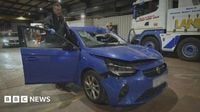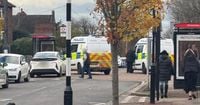In the early hours of September 30, 2023, a tragic collision on the A4042 dual carriageway in Newport, Wales, brought the dangers and legal ambiguities of electric scooter use sharply into focus. The incident, which resulted in the death of 26-year-old Alan Galudzinski, has since been the subject of a detailed investigation—one that not only unraveled the harrowing moments leading up to the crash but also highlighted the broader issues surrounding e-scooter regulation on public roads.
According to BBC reporting, Galudzinski, originally from Poland but living in Newport, was riding a privately-owned electric scooter in the middle of lane one on an unlit stretch of the dual carriageway. It was just before 1 a.m. when a blue Vauxhall Corsa, driven by an 18-year-old and traveling at the legal speed limit of 70 mph (112 km/h), struck him from behind. The impact was so forceful that it scattered Galudzinski’s socks, shoes, and jewelry across the carriageway—a detail that left even seasoned investigators stunned.
Police and paramedics arrived at the scene within minutes, but despite their efforts, Galudzinski was pronounced dead at the scene. The aftermath was chaotic: one of his shoes was found in the central reservation, the other on the opposite side of the road. In a twist that underscored the violence of the crash, it was a McDonald's cap found about 500 meters from the collision that ultimately helped officers identify the victim, after inquiries with local restaurants.
The investigation, led by Gwent Police and featured in the BBC documentary series Crash Detectives, quickly zeroed in on several factors that contributed to the tragedy. Forensic collision investigator PC Matt Rue, who was among the first on the scene, noted the unusual circumstances of the case. "Those scooters are illegal to use on the roads. They're illegal to use on pavements. They're illegal to use anywhere where the public has access," PC Rue told the BBC. "Unfortunately, a lot of people don't understand that or realise that. Not only are they illegal, but they make for very vulnerable road users."
Galudzinski’s scooter was found to be in sport mode, capable of reaching speeds up to 19 mph (30 km/h). It was equipped with a small front headlight and a red rear light, both of which were still functional after the crash. Yet, as PC Rue and his team reconstructed the accident, it became clear that visibility was a critical issue. During the nighttime reconstruction, officers placed a replica scooter and dressed an officer in the same clothing as Galudzinski. As the car’s headlights illuminated the road, the scooter’s red rear light was barely distinguishable from the red edge markers and cat’s eyes lining the carriageway. The design on the back of Galudzinski’s jacket—a circular motif—only added to the confusion, blending with a similar circular sign on the roadside and making it even harder for drivers to identify him as a hazard.
"All of a sudden we hit something and had no idea what it was," recalled the young driver, as quoted by the BBC. Both the driver and the passenger escaped with minor injuries, but the psychological impact of the event was profound. PC Rue later remarked, "I can imagine it was a very traumatic experience, and still probably continues to be so." No charges were brought against the driver, as the investigation concluded that, under the circumstances, the driver could not reasonably have been expected to avoid the collision. "Under no circumstances would you expect to see an e-scooter in the middle of lane one of a dual carriageway, in the dark," PC Rue emphasized.
The forensic team’s analysis was meticulous. An S-shaped mark on the road matched perfectly with a mark on the scooter’s tire, confirming Galudzinski’s position in the middle of the lane at the moment of impact. The damage to the Vauxhall Corsa, which began at the front bumper and continued up the windscreen and across the roof, provided further evidence of the severity and inevitability of the collision.
One of the most sobering findings from the investigation was that Galudzinski was more than twice the legal drink-drive limit at the time of the crash. "Intoxication maybe answered a lot of questions as to why he ended up being in the position and the circumstances that he found himself in," PC Rue told the BBC. This detail, while deeply saddening, helped explain why Galudzinski was riding in such a dangerous location at such a late hour.
Legally, the case was clear-cut. In the United Kingdom, privately-owned e-scooters are prohibited on public roads, pavements, and anywhere the public has access. Only e-scooters rented through government-approved trials are allowed on public roads, a distinction that is often lost on the public. As PC Rue observed, "Unfortunately, a lot of people don't understand that and don't realise that. But not only are they illegal, they make for very vulnerable road users." The incident has reignited debate about the need for clearer public education and stricter enforcement regarding e-scooter use.
The reconstruction conducted by Gwent Police was featured in the second episode of Crash Detectives, airing on BBC One Wales and BBC iPlayer on October 22, 2025. The episode provided viewers with a behind-the-scenes look at how collision investigators meticulously piece together the aftermath of fatal road incidents, using every scrap of evidence—from scattered clothing to subtle tire marks—to tell the story of what happened.
For Newport and the wider community, the tragedy serves as a stark reminder of the risks associated with e-scooter use outside legal parameters. The combination of poor visibility, high vehicle speeds, and unexpected road users can have devastating consequences. As the number of e-scooters on Britain’s roads continues to rise, incidents like this underscore the urgent need for greater awareness and responsible behavior—both from riders and from those behind the wheel.
While nothing can undo the loss suffered by Galudzinski’s family and friends, the hope is that the lessons learned from this investigation will prevent similar tragedies in the future. As PC Rue and his team have shown, the smallest details can make all the difference in understanding—and ultimately preventing—such heartbreaking events.





